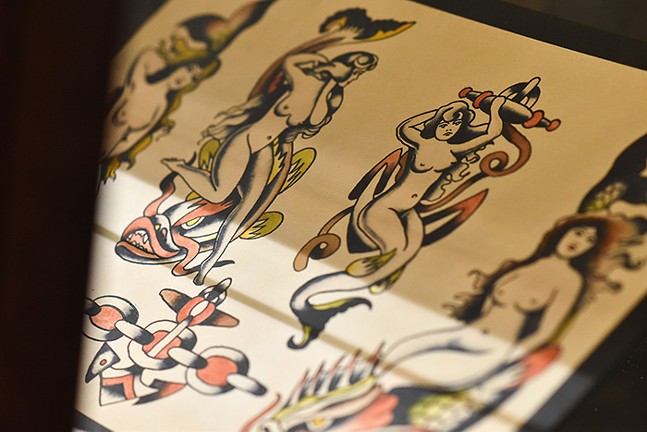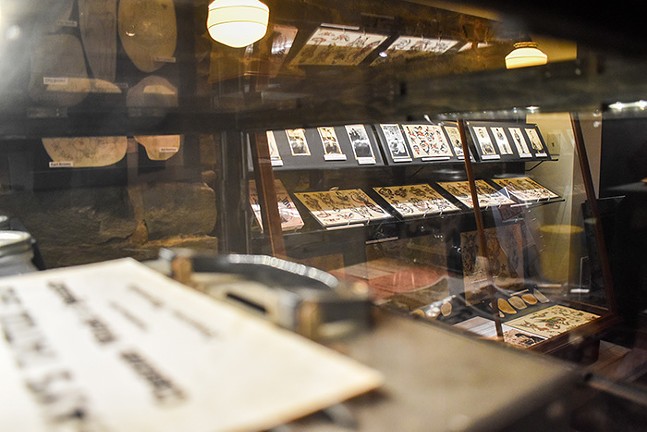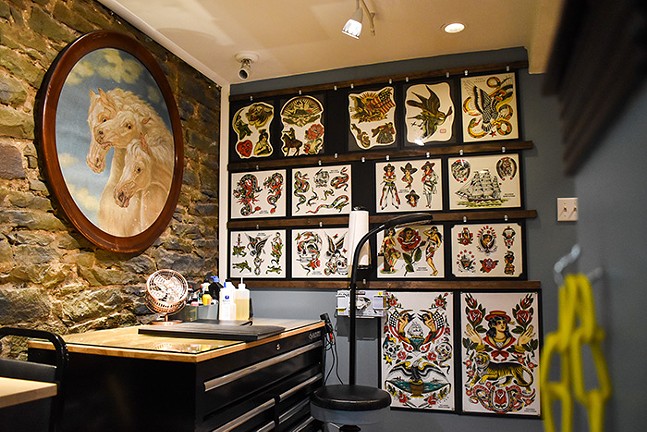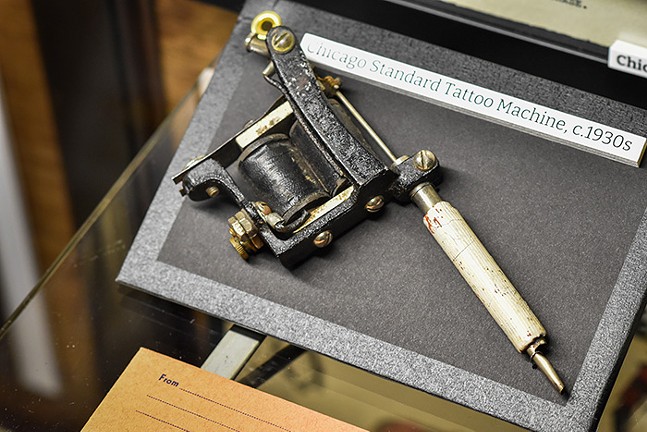The sketches, various tattoo designs in the traditional American style, are clearly done on the back of Alberts’ mail, including documents about his war veteran status and letters from his synagogue in Yiddish.
“Other tattooers would write to him, and he’d correspond with them and send them designs, you know?” Pittsburgh Tattoo Art Museum owner Nick Ackman tells Pittsburgh City Paper as he tattoos a customer at the back of his newly-opened museum earlier this month. “But when he sent them designs, he would just cut up his mail and draw shit on the back and send it back to them.”
As far as collectors know, there are only two sets of Alberts’ personal drawings in existence. Tattoo-artist-turned-fashion-mogul Ed Hardy owns one, and the other lives in Shadyside in Pittsburgh’s newest museum.
The Pittsburgh Tattoo Art Museum, open now on Walnut Street in Shadyside, pulls its exhibits from Ackman’s impressive collection of tattoo antiques that includes stencils, sketches, equipment, archival photos, and a traveling kit made from a hollowed-out record player once used by carnival tattooists. A self-taught curator, Ackman’s approach considers the way the history of tattoo art connects with many other parts of American history and culture. He hopes that even people who would never consider getting a tattoo will still come to the museum and find something that interests them.
“I tried to gear it to where it's interesting for people that have absolutely no interest in getting a tattoo whatsoever but are interested in things like American history or folk art or military history or anything that can go along with tattooing,” Ackman says.
Ackman and his partner Jill Krznaric run the museum by donation, and tattoo clients in the back of the shop. Ackman says he wanted to be able to offer visitors the opportunity to see tattoos in-progress. Donations to the museum will be put to use restoring and preserving artifacts of tattoo history.
Calling tattooing “the greatest American folk art,” Ackman tells City Paper that the visual culture of traditional American tattooing is a mix of “images from other American things, advertising, magazines, fruit crate labels, anything with cool images [tattooists] could steal from, they would take those images.”
“All of its imagery is this dialogue of all of these things that are so important to the people in any group or place that are doing those tattoos,” Ackman says. “If you analyze the designs off of any sheet, you can tell what the wants and the needs of the people of that place and time are, because it’s sex and religion and death and adventure … It’s kind of the same themes that we use today, too.”
Ackman says his love of collecting both items and the stories behind them comes from his childhood.
“When I was a little kid, my great aunt was a hoarder. But she wasn’t a hoarder of, like, trash and shit, her whole house was full of things, and she had them all up on shelves and all over her house and everything,” he says. “And when I was a kid, I'd walk into her house and I’d say, ‘Where’d you get that?’ or ‘Where’d you get this?’ and she had a story to tell me behind every object that was on her shelf. Her house was kind of curated, in a way, and I thought it was really interesting.”
Curation, Ackman says, is what distinguishes a museum from a collection.
“I’ve been to a lot of places that are described as tattoo museums, and some of the ones I’ve been to don’t have really great labeling,” Ackman says. “I think that’s more of a collection, not a museum.” He says that as he developed his displays for the museum, he observed how other, more traditional, museums approach labeling and context.
Throughout the Pittsburgh Tattoo Art Museum are labeled artifacts identifying the objects. Tattoo artwork is labeled by the artists’ names, if known, as well as a likely decade of origin. The “curatorial stuff has mostly been out of my own interest over time, but [I’m] trying to do my best to figure it out the right way,” Ackman says.
“Once you become a collector, then people want to see your collection, but you don’t want all those people coming to your house … so the museum is the best solution to be able to present your collection to people,” Ackman explains.
The museum’s first exhibit focuses on each of the seven books of tattoo art and memorabilia Ackman has published through his company, Blue Letter Books, which aims to “preserve the great craft of tattooing through books,” according to its website. He started Blue Letter Books in 2009 and has since published books of work by and about Lew Alberts, Milton Zeis, and Percy Waters, among others.

CP Photo: Pam Smith
What are American Traditional tattoos?
American Traditional, also called “Old School,” is a tattooing style featuring bold black lines and highly saturated solid blocks of mostly primary colors. The designs are usually relatively simple and two-dimensional. Unlike more realistic styles, American Traditional tattoos are supposed to look like drawings. Because American Traditional was so ubiquitous for so long, according to the website Tatt Mag (tattmag.com), it didn’t even need a name until much later when new styles began to develop.
American Traditional, also called “Old School,” is a tattooing style featuring bold black lines and highly saturated solid blocks of mostly primary colors. The designs are usually relatively simple and two-dimensional. Unlike more realistic styles, American Traditional tattoos are supposed to look like drawings. Because American Traditional was so ubiquitous for so long, according to the website Tatt Mag (tattmag.com), it didn’t even need a name until much later when new styles began to develop.
Exciting additions to his collection sometimes come to Ackman more or less by surprise, although he knows where to look. The rare Alberts sketches on display unexpectedly came to Ackman in a box of unsorted papers he bought that once belonged to legendary tattoo artist Walter Cleveland.
Ackman (who is not Jewish) says that when he “saw the Jewish stuff on the back and everything, I thought, ‘Wow, that'd be cool if these are actually Lew Alberts’ drawings!’ But I thought there’s no way they could be all that kind of stuff.” He posted some pictures to a tattoo history group online and, he says, tattoo historian Carmen Nyssen reached out right away to confirm Ackman’s sketches looked just like others she had studied. Later, he noticed Alberts’ name and address on the back of one of the sketches.
Ackman and Krznaric were both established tattoo artists when they met online about six years ago. Ackman was in Washington state at the time and Krznaric was in Texas. They both moved to Cannonsburg, Pa. where Krznaric began tattooing at Old Soul Tattoo and Ackman commuted to a tattoo shop in Morgantown, W. Va. Now they live in Bellevue.

CP Photo: Pam Smith
On Tattooing in Pittsburgh
Jill Krznaric started tattooing in McKeesport in 2001. Compared to other places she’s tattooed, she says the Pittsburgh tattoo community seems to have an uncommon camaraderie. “I was in Houston, and we had a tattoo shop across the street, and nobody talked to each other,” she says.
Both Krzniack and Nick Ackman, who run the Pittsburgh Tattoo Art Museum together, are especially excited for other local tattooers to visit the museum. “There are a lot of really talented people around here,” Krznaric says, “and there’s a lot of people that have been tattooing here for a long time.”
Jill Krznaric started tattooing in McKeesport in 2001. Compared to other places she’s tattooed, she says the Pittsburgh tattoo community seems to have an uncommon camaraderie. “I was in Houston, and we had a tattoo shop across the street, and nobody talked to each other,” she says.
Both Krzniack and Nick Ackman, who run the Pittsburgh Tattoo Art Museum together, are especially excited for other local tattooers to visit the museum. “There are a lot of really talented people around here,” Krznaric says, “and there’s a lot of people that have been tattooing here for a long time.”
Ackman says people he worked with 15 years ago have been writing him, surprised that he finally got it together.
“Whenever I met some of Nick’s friends, they told me it might take him 10 years,” Krznaric says, “but he always does what he says he’s gonna do.”
The Pittsburgh Tattoo Art Museum. 5413A Walnut St., Shadyside. pittsburghtattooartmuseum.com and instagram.com/pittsburghtattooartmuseum
11 a.m.-6 p.m. Thursday-Sunday. For tattoos, contact the museum to schedule.




